Malton, North Riding of Yorkshire
Up to 1834
Malton had several early workhouses on the same site at Sheepfoot Hill. The first, operating from 1735, was located in a stone house known as Spring Hall.
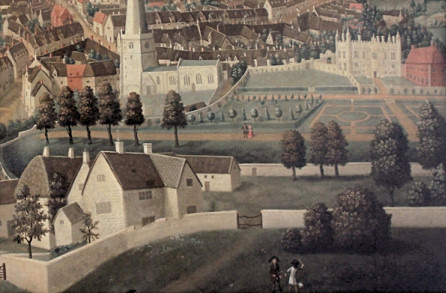
A 1728 view of Spring Hall from the south east.
In 1789, the workhouse was rebuilt in brick and could accommodate 120 paupers. It had a treadmill, which was used both to pump water for the workhouse, and to provide a punishment task for the inmates. A stone plaque records the rebuilding which was partly financed by a £200 donation from Lord of the Manor, Earl Fitzwilliam. At this time, paupers were "farmed" by the workhouse governor who received so much per head per week from the parish to feed, clothe and provide them with work.
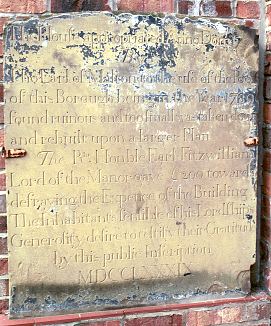
Malton commemorative plaque, 2001.
© Peter Higginbotham.
|
The House appropriated Anno Domini By The Earl of Malton to the use of the Poor of this Borough being in the Year 1789 found ruinous and too small was taken down and rebuilt upon a a larger Plan. The Rht Honble Earl Fitzwilliam Lord of the Manor gave £200 towards defraying the Expence of the Building. The Inhabitants, sensible of his Lordship's Generosity, desire to testify their Gratitude by this public Inscription. MDCCLXXXIX |
Rillington was the centre of a Gilbert Union which in 1821 included up to fifty parishes reaching from Skirpenbeck to Gristhorpe near Filey (Mitchelson, 1953). Other members of the union included Lebberston, Helperthorpe, Netwon-on-Ouse, Ebberston, Folkton, Sutton-on-Derwent, Netwon-on-Derwent, and Howsham (Huddleston, 1954). The union had a workhouse at Rillington, situated at the north end of Low Moorgate.
After 1834
Malton Poor Law Union formally came into existence on 12th January, 1837. Its operation was overseen by an elected Board of Guardians, 70 in number, representing its 68 constituent parishes and townships as listed below (figures in brackets indicate number of Guardians where this was more than one):
East Riding of Yorkshire: Acklam with Barthorp, Birdsall, Burythorp, Daggleby, Eddlethorpe and Grange, Firby, North Grimston, East Heslerton, West Heslerton, Howsham, Kennythorp, Kirkham (Kirby Underdale), Knapton, Kirby Grindalyth, Langton, Leavening, Leppington, Menethorpe, Norton, Raisthorp, Rillington, Scagglethorpe, Scamston, Settrington, Teddingham, Thirkleby, Thorpe Bassett, Westow, Wharram-le-Street, Wharram Percy, Winteringham.North Riding of Yorkshire: Amotherby, Appleton-le-Street, Aryholme and Howthorpe, Barton-le-Street, Barton-le-Willows, Brawby, Broughton, Bulmer, Butterwick, Coneysthorpe, Crambe, Foston, Fryton, Ganthorpe, Great Habton, Little Habton, Henderskelf, Hildenly, Hovingham, Hutton's Ambo, Old Malton, New Malton — St Leonard's and St Michael's (2); East Ness, West Ness, Ryton, Salton, Scackleton, Sheriff Hutton with Cornbrough, Slingsby, Southolm, Stittenham, Swinton, Terrington and Wiganthorpe, Thornton-le-Clay, Wath, Welburn, Whitwell-on-the-Hill.
The population falling within the Union in 1831 had been 20,951 with parishes and townships ranging in size from Hildenly (population 12) to New Malton (4,173). The average expenditure on poor relief for 1834-6 had been £7,406 or 7s.1d. per head of the population.
The new Malton Union took over the Sheepfoot Hill site and in around 1838 the buildings were enlarged to accommodate 160 inmates. The site location and layout are shown on the 1850 map below:
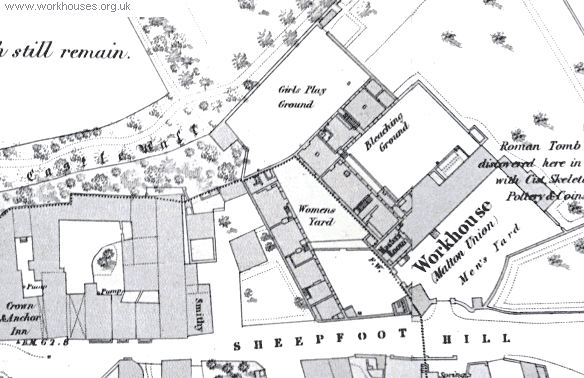
Malton workhouse site, 1850.
The main building was a U-shaped structure with a separate parallel range to the south-west. Male inmates were housed at the south-east of the site and females at the north-west.
In 1866, an official inspection criticised the workhouse's ventilation, lighting, water supply, washing facilities, and privies. It concluded that a new workhouse was urgently required. This never took place, although there were alterations and additions to the buildings in 1893 — male and female infirmaries being erected at the east of the site, and a casual ward block at the west. The expanded site layout is shown on the 1926 map below:
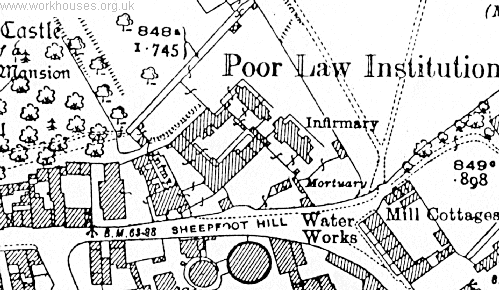
Malton workhouse site, 1926.
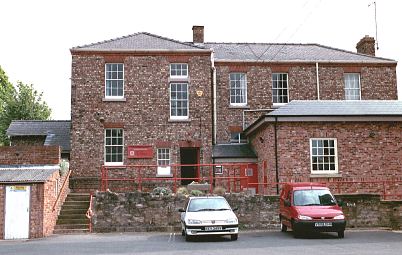
Malton male infirmary block from the south-west, 2001.
© Peter Higginbotham.
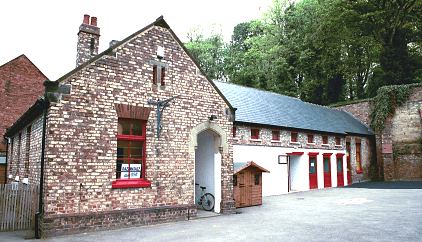
Malton casual wards from the south-east, 2001.
© Peter Higginbotham.
On November 4th, 1901, William Copley, master of the workhouse for the previous eight and a half years, was charged at Malton Police Court with falsifying accounts and forging tradesmen's signatures, with the intention of defrauding the Guardians of the Union. Copley was alleged to have large number of such acts. In the previous April, he had paid a local grocer, William Wardell, the sum of £1 12s 6d. for five stones of Yorkshire bacon but had then claimed reimbursement of £2-3s.-9d. In May, he had submitted receipts which were purported to be payment to provision Merchant, Mr R.S. Wallgate, for a consignment of yellow soap, even though no soap had in fact been supplied. On another occasion, he had pretended to order 24lbs. of lard from Mr William Baker and forged a receipt to the amount of 16s. Copley was committed for trial at York Assizes.
After Boards of Guardians were abolished in 1930, and the workhouse site was taken over by the County Council, it briefly became a hospital under its original name of Spring Hall, but closed in 1934. The casual ward was in use until 1940.
The former workhouse site is now largely occupied by modern housing. The male infirmary ward now forms part of a fire station. The former casual ward is now occupied by a local pre-school play-group.
Cottage Homes
The Malton Union established a children's cottage home at St Leonard's House, 45 Old Maltongate, Malton. In 1924, the home could accommodate 25 children with Kate Cope as the Foster Mother in charge.
Staff
Inmates
Records
Note: many repositories impose a closure period of up to 100 years for records identifying individuals. Before travelling a long distance, always check that the records you want to consult will be available.
- North Yorkshire County Record Office, Malpas Road, Northallerton DL7 8TB. Virtually no local records survive.
Bibliography
- Hastings, P Malton Workhouse (Ripon Museum Trust leaflet, 1996).
- Huddleston, N (1954) Rillington
- Mitchelson, N (1953) The Old Poor Law in East Yorkshire (East Yorkshire Local History Society - Pamphlet No.2).
Acknowledgement
- Thanks to Nigel Copsey for Spring Hall illustation.
Links
- None.
Unless otherwise indicated, this page () is copyright Peter Higginbotham. Contents may not be reproduced without permission.


